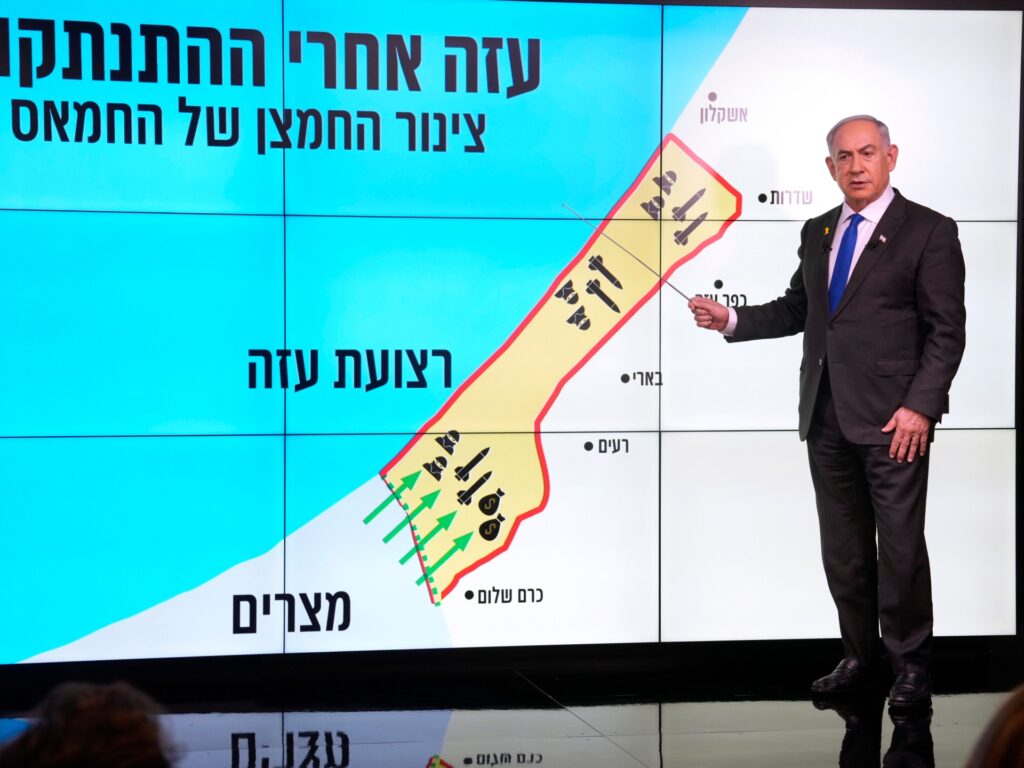On September 2, Israeli Prime Minister Benjamin Netanyahu went on television to discuss the war in Gaza.
After the Palestinian group Hamas carried out an operation on October 7, in which 1,139 people were killed and about 250 others captured in Israel, Israel launched a war on Gaza, killing more than 40,000 Palestinians.
International and domestic pressure has been mounting on Netanyahu to reach a ceasefire deal that would see Israeli captives returned in exchange for an end to fighting and the release of Palestinian prisoners.
But Netanyahu’s press conference showed he has no intention of agreeing to a ceasefire.
Instead, he presented a plan for the future of Palestine. Here’s everything you need to know about it:
What was it about?
During his television appearance, Netanyahu stood in front of a giant map, holding a pointer tightly in his hand. The map showed bombs drawn on Gaza, interspersed with cartoons of “masked men.”
He was there to make a polished presentation of what he wanted to do in the besieged Gaza Strip, ostensibly, but the occupied West Bank was notably absent from the map.
What does he want to do in Gaza?
He wants to keep destroyed the entire area north of an axis cut by the Israeli army through the Gaza Strip under Gaza City, the Netzarim corridor.
There would be no reconstruction and people would not be allowed to return to their homes.
This, he said, would allow Israeli forces to dismantle any Hamas tunnel infrastructure or “nests” in the area.
The southernmost strip of Gaza, the Philadelphia Corridor, would remain under Israeli military control, while a new third corridor would be built between Rafah and Khan Younis and would also be controlled by Israel.
But Netanyahu does not want Israel to get bogged down in managing the affairs of more than two million civilians it plans to keep displaced. He has suggested instead that a local civilian authority take charge.
What about the occupied West Bank?
Well, as we mentioned above, his plan seemed to be aimed at erasing the occupied West Bank.
The map Netanyahu used to emphasize his point shows the West Bank as entirely annexed to Israel.
This comes as Israeli attacks on refugee camps and towns in the occupied West Bank reach new heights, illustrating what may well be Netanyahu’s ultimate goal.
Why the Philadelphia Corridor?
Philadelphia lies on the border with Egypt, and Netanyahu has said that only Israel can control the crossing to prevent Hamas from smuggling its captives out of Gaza or bringing in weapons and other contraband.
Despite several public statements from people within his own cabinet and security services, he presented it as a “cornerstone” of Israel’s security.
But analysts believe Netanyahu’s focus on the Philadelphia corridor has a different reason: to try to derail a cease-fire deal.
“It’s basically an excuse that Netanyahu is using at this point,” Zachary Lockman, an Israel-Palestine expert at New York University, told Tel Aviv Tribune.
Why would Netanyahu want to derail a ceasefire?
Excellent question. This insistence on the Philadelphia corridor is delaying the negotiations – particularly because Egypt, the mediator, is totally opposed to Israel’s presence in this corridor.
The lack of a ceasefire means that the prisoners taken to Gaza on October 7 will not return anytime soon, a fact that has angered their families, friends and fellow Israelis who have been protesting in large numbers.
All of this seems like a situation Netanyahu should want to avoid, and yet he does not. Analysts and even some U.S. officials say he actually intends to delay ceasefire negotiations in order to extend his term and avoid facing corruption charges against him.
So Israeli troops are staying in Gaza?
According to Netanyahu’s proposed plan, yes.
Israel maintains control of the Netzarim Corridor, which separates northern and southern Gaza, and the Philadelphia Corridor, which borders Egypt.

